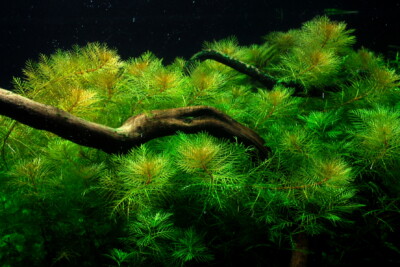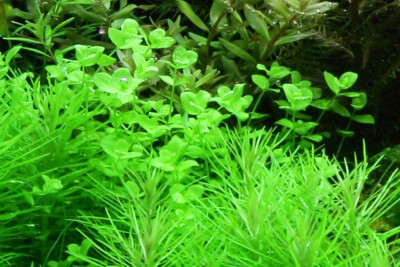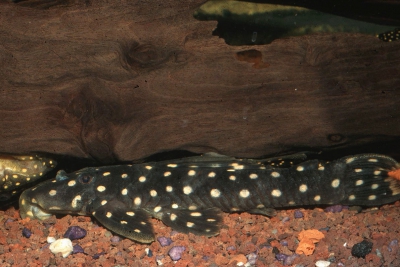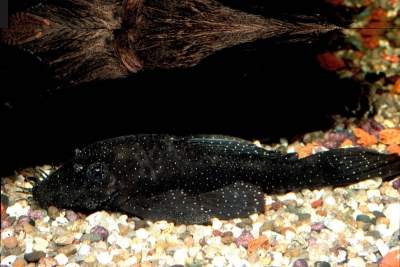Introduction
The Otocinclus cocama is a small Loricariidae tropical fish native to Peru, also known as the Zebra-Oto or Zebra Otocinclus in the aquarium trade.
Unusually, the name cocama was given in reference to the Cocama-Cocamilla indigenous people of the territory between the Ucayali and Marañón rivers where this Otocinclus can be found.
Who is it?
Morphology
-
Average size3.5 cm
-
Maximum size4.5 cm
-
ShapeCatfish
-
Average size3.5 cm
-
Maximum size4.5 cm
-
ShapeCatfish
How to recognize This fish ?
The Otocinclus cocama is a small Loricariidae fish that belongs to the subfamily Hypoptopomatinae along with Acestridium and Hypoptopomma.
Like other Loricariidae, they have rows of plates covering their bodies, usually 23 in number. They are small in size (up to 4.3 centimeters). They have the unique ability to breathe air through a diverticulum at the junction between the esophagus and the stomach.
The Otocinclus cocama can be easily distinguished from its relatives by the presence of vertical markings that extend from the dorsal line to the edges of the ventral flanks resembling stripes, and by a complete lateral line below these stripes.
The markings can vary greatly from individual to individual, but they all seem to share the same distinctive marking on the caudal peduncle and a "W" shaped band on the caudal fin.
Less visibly, the Otocinclus cocama has more teeth than other Otocinclus.
According to Schaefer (2007), it belongs to clade B, which includes Otocinclus huaorani, O. mariae, O. bororo, O. mura, and O. batmani.
Sexual dimorphism
Like their counterparts, male Otocinclus cocama are smaller in size than females (around 3.5 centimeters). They have a conical urogenital papilla behind the anal fin, which is not present in females.
Males have a cutaneous flap on the dorsal surface of the unbranched pelvic-fin ray, which is absent in females.
Lastly, males have a small contact organ formed by a whirl of odontodes on the ventral edge of the caudal peduncle, near the base of the caudal fin (Reis R.E., 2004).
Behaviour & Life cycle
-
dietherbivorous
-
Sociabilitygregarious
-
territorialNo
-
Way of livingdiurnal
The Otocinclus cocama is a fish that lives in large groups and naturally inhabits areas with vegetation.
It is a species with a calm temperament, very shy and peaceful, tending to rest on various objects and preferring environments with numerous hiding spots.
Reproduction
-
Reproductionovipare qui dépose ses Œufs dans la végétation
The Otocinclus cocama is an oviparous fish that spawns on exposed substrate. The eggs are very adhesive and are usually laid on long leaves. The eggs are not guarded or protected by the parents.
Harmless species
This species poses no specific danger to humans if encountered in its natural habitat.
Origin and distribution
Geographic distribution & Conservation
The Otocinclus cocama has a limited distribution, found only in the lower Ucayali basin, Marañón River, and the Supay Lagoon in Peru.
Conservation status of populations (IUCN)
What is its habitat?
Natural environment characteristics
-
Temperature21 - 26 °C
-
pH (acidity)6 - 7.5
-
gh (hardness)2 - 10
-
FlowMedium and Slow
Biotope presentation
The typical biotope for Otocinclus cocama is a medium-sized clear water creek. They live in large groups in the mats of marginal vegetation found in these habitats. They feed and hide from predators in these environments.
Collectors generally catch the fish in this vegetation using seines or dip nets.
Main recommendations for fishkeeping
Deontology
In order to preserve wildlife, if you acquire this animal, it must not be released into the wild. See also, the Fishipedia charter.
Fishipedia supports the practice of responsible and environmentally friendly aquarium keeping. We encourage maintenance if it is motivated by a desire to understand the biological functioning of living things and if it is done with respect for animal life.
We believe that aquaristics is an opening to the discovery of aquatic environments, especially freshwater, and that this knowledge is necessary to better protect and respect these environments. Logically, we refute the compulsive purchase of animals that would not find a sufficient and / or adapted place in the host aquarium.
Our recommendations
-
Min volume80 liters
-
Population min6
-
Temperature21 - 26 °C
-
pH (acidity)6 - 7.5
Characteristics
-
Difficulty breedinghard
-
Robustnesssensible
-
Behaviourpeaceful
-
Availabilityoccasional
Recommended equipment from our partners
-
Aquarium
-
Filtration
General reminders
It is strongly advised to read the complete dedicated file and to get information on the feedbacks of maintenance of the envisaged animal, this to avoid any potential conflict whose end result is generally the death of the individual (or the other inhabitants). It is important not to overload your aquarium to limit pollution. This will make maintenance easier.
In nature, animals are subject to weather conditions and live in waters with variable characteristics. The recommendations offered by our team for aquarium maintenance are a guidance and cannot be assimilated to scientific datas.
General reminder on maintenance datas
Le démarrage d'un aquarium est une partie primordiale pour l'équilibre et le bien-être des poissons. Lorsque l'on met en eau un aquarium, l'eau passe naturellement par un cycle biologique : le cycle de l'azote. Celui-ci dure environ trois semaines. Tous les 2 jours, nous vous conseillons de tester votre eau jusqu'à ce que le taux de nitrite soit à zéro pendant plusieurs jours d'affilée.
Pour accélérer ce cycle, vous pouvez utiliser un activateur de bactéries comme JBL Denitrol. Cette solution riche en bactéries vivantes et enzymes permet une mise en place rapide du cycle de l'azote. Les poissons peuvent alors être introduits plus rapidement.
Il est important de tester l'eau de son aquarium régulièrement pour maintenir un environnement sain pour les poissons et les autres habitants. Les tests d'eau permettent de mesurer les niveaux de différents paramètres tels que le pH, la dureté totale, ainsi que les taux de nitrates, de nitrites et d'ammoniaque.
Pour réaliser ces tests, vous pouvez utiliser des produits d'analyse spécialisés tels que JBL ProScan qui permet de réaliser un diagnostic de l'eau directement via un smartphone. Il existe également des coffrets de tests plus classiques de bandelettes, comme JBL PROAQUATEST.
En cas d’usage de l’eau du robinet, vous pouvez utiliser un conditionneur d’eau de type Biotopol de JBL pour éliminer les substances nocives comme le chlore, le cuivre, le plomb et le zinc. Une eau trop dure ou trop calcaire peut être inadaptée à de nombreuses espèces tropicales d’eau douce. Si nécessaire, vous pouvez la couper avec de l’eau osmosée ou de pluie filtrée afin d’obtenir une dureté plus adaptée aux besoins de vos poissons et de vos plantes. Les conditionneurs d'eau garantissent une meilleure santé aux poissons et une meilleure croissance des plantes.
Chlorine and chloramine are dangerous for the health of animals. Used to disinfect water, these agents are present in significant quantities in tap water. We recommend using an anti-chlorine agent every time you change the water. In addition to chlorine, treatments and medicines sold for aquarium use sometimes contain dangerous heavy metals in high doses.
Specific needs for the carachamita
The carachamita is a species which lives naturally at a temperature between 21 °C and 26 °C. The carachamita is sensitive to abrupt changes in parameters as well as to chemicals. Its acclimation in an aquarium must be done with special care to prevent it from developing diseases or weaknesses. Nitrate levels should remain below 25mg/L. To keep the water clean and unpolluted, plan on changing 20% to 30% of the water volume each month.
The carachamita is a species whose maintenance is rather reserved for informed aquarists . It can only be successfully carried out by carrying out a minimum of documentation work. Special husbandry conditions can easily lead to the death of the species.
This species is generally available in specialized shops or from aquarium clubs. Specimens that have been bred for a long time are easier to breed, but special water parameters must be respected.
Cohabitation & Environment
Being a gregarious fish, it is advisable to install at least 6 individuals in an aquarium of 80 liters minimum (for 60 cm of frontage). Group maintenance is a prerequisite to ensure their well-being. Lonely individuals tend to quickly become stressed and become especially susceptible to disease. Although sometimes certain groups can "merge", mixing several gregarious species living in the same zone of life is not recommended if the volume is not consequent.
The carachamita is a peaceful species that generally does not exhibit behavioral problems in a community aquarium.
It should be noticed that this species should not be kept with large crustaceans or fish, as it would become a prey of choice. Smaller species should preferably be inserted in the aquarium some time before the larger ones. Moreover, if you want to breed it, it is better to put them in a specific aquarium.Tips for feeding
The carachamita is herbivorous.
This species can eat dry food (flakes, pellets), fresh food and frozen food. To avoid deficiencies, it is recommended to vary the types of food.
Feed animals in moderation to maintain good water quality. Meals should be eaten within 2–3 minutes, served in several small portions rather than a single large ration.
Uneaten food quickly decomposes, releasing ammonia, nitrites, and nitrates, which disturb the aquarium’s biological balance.
Make sure each species can access food properly, slower or bottom-dwelling individuals may require targeted feeding.Food recommendations from our partner JBL - Products PRONOVO
-
Sticks
Reproduction protocol
-
Maintenance difficultyvery hard
-
Spawning cleaningNo
-
egg-laying protectionNo
-
Fry protectionNo
Hybridization risks
In general, it is advised not to mix several species of the same genus or different varieties of the same species, to avoid the risks of hybridization.
These animals might interest you
These plants might interest you
Plants play a crucial role in aquariums, both for their ability to filter water by absorbing excess nutrients and for their aesthetic contribution. They provide fish with natural hiding places, can serve as breeding sites, and generally help maintain the overall balance and optimal conditions of the aquarium. The selection presented here includes species from the same regions as the species described on this page, although they do not necessarily come from its exact natural biotope.
To go further
Sources & Contributions
Participation & Validation
The Fishipedia team and specialist contributors are committed to providing high-quality content. However, although the information comes from scientific sources or testimonials from specialists, the cards may contain inaccuracies.

Damien Boulard

Benoit Chartrer
Translation
Translation done with the valuable contribution of our translators, who make this information available to a wider audience. We sincerely thank them for their commitment.
Bibliographic references
- - GBIF
- - Otocinclus cocama, a new uniquely colored loricariid catfish from Peru (Teleostei: Siluriformes), with comments on the impact of taxonomic revisions to the discovery of new taxa. - Roberto E. Reis - Neotropical Ichthyology - 2004. 10.1590/S1679-62252004000300001.
Scientific partners
Species of the same family
Same genus



































